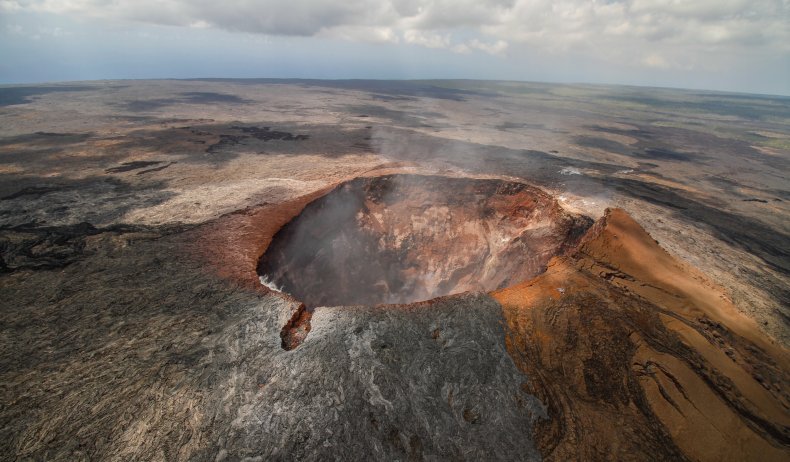BY ROBYN WHITE ON 10/13/22
The Mauna Loa summit remains closed as 65 earthquakes have hit the huge volcano in one day.
In the past 24 hours prior to Wednesday morning local time, the Hawaiian Volcano Observatory detected 65 small-magnitude earthquakes below the summit caldera, and the northwest flank of the volcano, according to the latest report from the U.S. Geological Survey (USGS).
Mauna Loa is the largest volcano on the planet. It is also considered one the most active volcanoes on Earth. It is one of five forming Hawaii and it rises 13,000 feet above sea level
The volcano has been rumbling to life in recent weeks. Heightened unrest began in mid-September, when the observatory recorded increased earthquakes in the area. In recent days, the earthquake activity increased from 10 to 20 a day, to 40 to 50 a day, according to the USGS update.

An aerial view of the crater of the Mauna Loa volcano.
Some 65 earthquakes have hit the huge volcano in 24 hours.
CSTORZ/GETTY
In recent weeks, the rumblings have become so heightened that the USGS is now issuing daily updates on the volcano's activity.
It has been issued a yellow color code, meaning it is under an "advisory." The color is a step above green, indicating normal behavior. Above yellow are orange, indicating that the activity is being watched, and red, which constitutes a warning.
On October 5, the National Park Service announced the summit would be closed until further notice due to the increase in seismic activity.
The USGS has stressed that the volcano is not erupting even though it "continues to be in a state of heightened unrest." The unrest is indicated by the increased earthquakes in the area and inflation of the summit.
Newsweek has contacted the USGS.
In recent weeks, the rumblings have become so heightened that the USGS is now issuing daily updates on the volcano's activity.
It has been issued a yellow color code, meaning it is under an "advisory." The color is a step above green, indicating normal behavior. Above yellow are orange, indicating that the activity is being watched, and red, which constitutes a warning.
On October 5, the National Park Service announced the summit would be closed until further notice due to the increase in seismic activity.
The USGS has stressed that the volcano is not erupting even though it "continues to be in a state of heightened unrest." The unrest is indicated by the increased earthquakes in the area and inflation of the summit.
Newsweek has contacted the USGS.
Volcanologist and Earth scientist at the University of Hull, Rebecca Williams told Newsweek that unrest depicts changes from the normal state of the volcano.
"Heightened unrest might mean that there is an increase in volcanic tremors perhaps, or a change in the volcanic gases emitted. Because unrest is essentially a deviation from background [or] normal behavior for a particular volcano, how unrest manifests is different for each volcano."
Williams said that volcanic unrest is normally related to a change in the magma plumbing system of a volcano, which may indicate that magma is moving.
"Unrest may or may not lead to an eruption. At Mauna Loa, my understanding is that there has been an increase in seismic activity and inflation [for example] the ground is swelling, and that the USGS think this signals that magma is moving at depth under the volcano," Williams said. "They have heightened the alert level accordingly. The volcano is very actively monitored. This kind of unrest does occur and does not always lead to an eruption—it's not unexpected but should always be treated with caution. Magma may be renewed, or move, within the deep volcanic system and stall before it reaches the surface to cause an eruption. Unrest can also be the precursory signals that an eruption may occur, hence the precaution."
Mauna Loa last erupted from March 25 to April 15, 1984. This followed nearly two years of increased seismic activity.
No comments:
Post a Comment